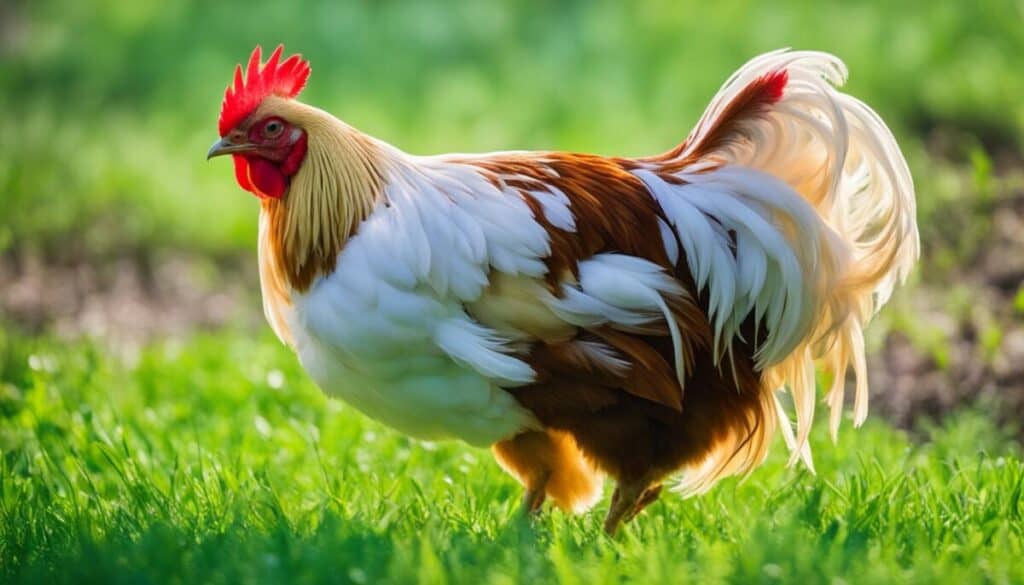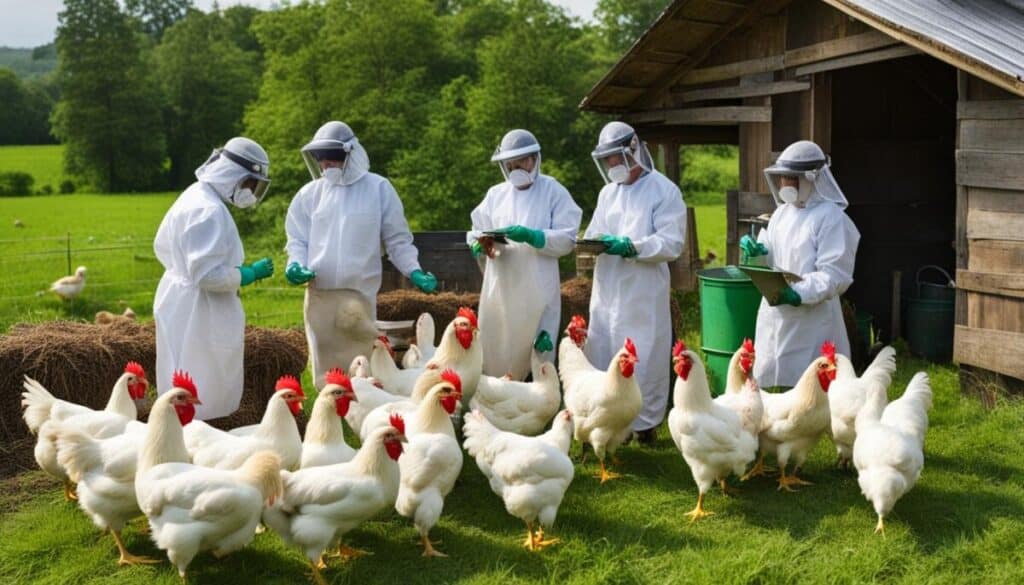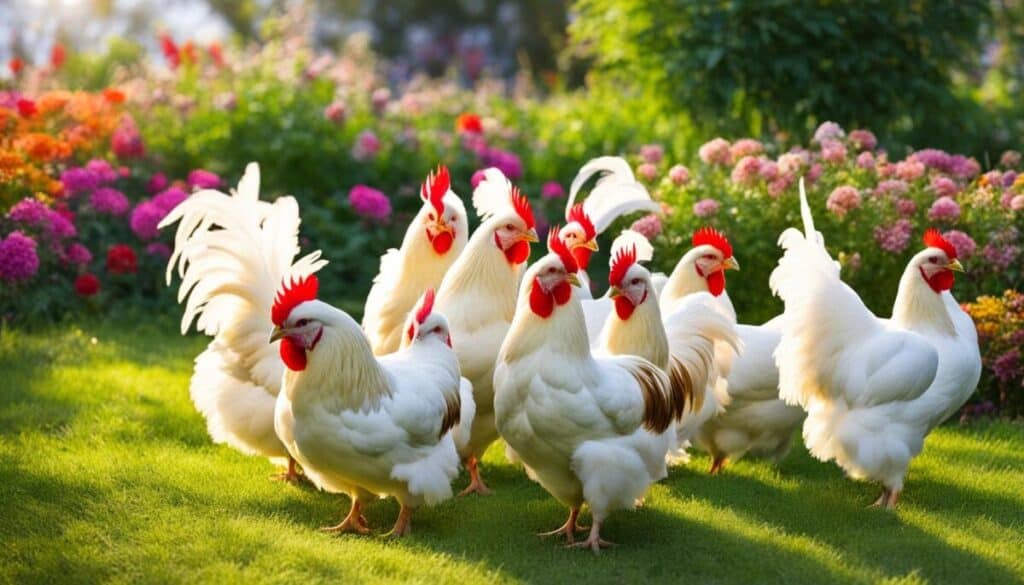If you’re considering raising chickens, Pekin chickens are a great choice. Not only are they an attractive breed with their fluffy feathers and bright colors, but they are also docile and easy to care for. Pekin chickens are a popular breed for both novice and experienced chicken keepers because of their excellent egg-laying abilities and friendly nature.
In this section, we will provide you with essential tips and information on how to raise Pekin chickens. From Pekin chicken breeds to care requirements, egg production, and finding reputable breeders, we’ve got you covered. By the end of this section, you will have all the knowledge you need to begin raising your own flock of Pekin chickens.
Key Takeaways:
- Pekin chickens are a great breed for both beginner and experienced chicken keepers.
- Pekin chickens are known for their excellent egg-laying abilities and friendly personalities.
- Proper care and nutrition is essential for the overall health and productivity of your Pekin chickens.
- Choose the right Pekin chicken breed according to your specific needs and preferences.
- It’s important to find a reputable breeder to ensure healthy and genetically diverse birds for your flock.
Choosing the Right Pekin Chicken Breed
One of the most enjoyable aspects of raising Pekin chickens is choosing the breed that best suits your needs. Pekin chickens are available in various breeds, each with their own unique characteristics and color variations. Understanding the differences between these breeds is crucial in selecting the right chickens for your flock.
Pekin Chicken Breeds
There are several Pekin chicken breeds available, including the standard or American Pekin, the bantam Pekin, and the frizzle Pekin. The standard Pekin is the most popular and widely available breed, while the bantam Pekin is a smaller version and ideal for those with limited space. The frizzle Pekin, on the other hand, has curly feathers, making them a visually striking addition to your flock.
Pekin Chicken Facts
Did you know that Pekin chickens are known for their docile and friendly nature, making them great pets? They are also one of the heaviest chicken breeds, with hens weighing up to eight pounds. Their egg production is impressive, with hens laying around 200-300 eggs per year.
Pekin Chicken Colors
Pekin chickens come in various colors, including white, black, blue, buff, and lavender. White Pekins are the most common color and are prized for their snow-white feathers and bright red comb and wattles. Black Pekins have shiny black feathers with a beetle-green gloss, while buff Pekins are a warm, golden color.
Choosing the right Pekin chicken breed will depend on your needs and preferences. Whether you are looking for a friendly pet or a productive egg-layer, there is a Pekin breed that will fit your needs.
Setting Up a Coop and Chicken Run
When it comes to raising Pekin chickens, providing a suitable living space is crucial for their health and well-being. In this section, we will guide you on setting up a coop and chicken run that meets the specific needs of your flock.
First, consider the size of your flock and choose a coop that provides ample space for them to move around. A good rule of thumb is to allow four square feet of indoor space and four square feet of outdoor space per bird. Ensure that the coop is well-ventilated and has sufficient natural light.
Next, think about the materials needed to construct your coop. You can use wood, metal, or plastic, depending on your preference and budget. Make sure the materials are sturdy and can withstand harsh weather conditions.
It is also essential to provide amenities such as perches, nesting boxes, and a safe nesting area. These will keep your Pekin chickens comfortable and secure during the night.
For the chicken run, choose an area that is spacious and secure. The run should be enclosed with chicken wire to prevent predators from preying on your flock. You should also consider adding a roof or netting to protect your birds from flying predators such as hawks.
Overall, setting up a suitable coop and chicken run is essential for Pekin chicken care and their well-being. With the right materials, space, and amenities, your Pekin chickens will thrive in their new home.
Feeding and Nutrition for Pekin Chickens
Proper feeding and nutrition are crucial for the overall health and egg production of your Pekin chickens. As omnivorous birds, Pekin chickens require a balanced diet consisting of protein, carbohydrates, vitamins, and minerals.
Commercial feeds formulated for poultry provide adequate nutrition. However, you can supplement their diet with fresh fruits, vegetables, and grains. It’s important to note that free-feeding or overfeeding can lead to obesity, which can cause health problems such as heart disease and reduced egg production.
The table below shows recommended daily feeding guidelines for adult Pekin chickens:
| Food Type | Amount per chicken per day |
|---|---|
| Commercial feed | 1/4 to 1/2 cup |
| Fruits and vegetables | 1/2 cup |
| Grains or seeds | 1/4 cup |
Additionally, clean water should be available at all times. Regularly change the water in their container to avoid bacterial contamination, which can cause diseases. Avoid giving your Pekin chickens food that is spoiled or moldy, as it can make them sick.
It’s also worth noting that certain foods should be avoided in their diet, such as chocolate, avocado, and anything high in salt or sugar. These foods can be toxic to chickens and cause health problems.
Pekin Chicken Health and Common Issues
As with any animal, maintaining good health is crucial for the well-being of your Pekin chickens. Here are some common health issues to watch out for and tips for prevention and treatment.
Respiratory Issues
Pekin chickens are prone to respiratory infections, which can be caused by various factors, including poor ventilation, overcrowding, and exposure to cold drafts. Symptoms can include coughing, sneezing, nasal discharge, and difficulty breathing. To prevent respiratory issues, make sure your chicken coop has adequate ventilation and clean bedding. If your chickens exhibit symptoms, isolate them from the rest of the flock, provide warm, dry shelter, and consult a veterinarian if necessary.
Parasites
External and internal parasites such as mites, lice, and worms can cause discomfort, weight loss, and decreased egg production in your chickens. Inspect your chickens regularly for signs of infestation, such as feather loss and irritability, and treat them with appropriate medication. Keeping the coop clean and providing regular dust baths can also help prevent parasites.
Egg Laying Issues
Pekin chickens are bred for their meat, but they also produce eggs. However, like any other breed, they may encounter egg-laying issues such as egg binding or low egg production. To promote healthy egg-laying, make sure your chickens have a balanced diet, clean water, and a comfortable nesting area. If you suspect egg-laying issues, consult a veterinarian for advice.
A Note on Antibiotics:
While antibiotics can be effective in treating bacterial infections in chickens, their overuse can lead to antibiotic-resistant bacteria that can harm both animals and humans. Always consult a veterinarian before administering antibiotics to your chickens and follow their instructions carefully.
By practicing good Pekin chicken care and keeping an eye out for potential health issues, you can help your flock stay healthy and productive for years to come.
Pekin Chicken Egg Production
Pekin chickens are known for their excellent egg-laying capabilities, making them a popular choice for backyard flocks. Understanding their egg production patterns and breeding considerations is essential for maintaining a consistent supply of fresh eggs.
Egg-Laying Patterns
Pekin hens typically begin laying eggs at around six months of age and can produce up to 200 eggs per year. Their eggs are large and white, making them a desirable choice for many households. Pekin chickens also tend to lay eggs less frequently during hot summer months and may stop laying altogether during the winter.
Breeding Considerations
Pekin chickens can breed naturally or using artificial insemination. Breeding can be a complex process, requiring careful monitoring and control over environmental factors such as light and temperature. Consulting with a reputable breeder or veterinarian is recommended to ensure successful breeding.
| Factors That Affect Egg Production | Solutions |
|---|---|
| Lack of Proper Nutrition | Provide a well-balanced diet that includes essential vitamins and minerals. |
| Stress | Reduce environmental stressors such as overcrowding and risk of predators. |
| Inadequate Lighting | Provide at least 14 hours of light per day to stimulate egg production. |
By addressing these factors, you can ensure optimal egg production and health for your Pekin chickens.
“Pekin chickens are known for their large, white eggs and consistent egg-laying patterns, making them an excellent choice for backyard flocks.”
Breeding Pekin Chickens
Breeding Pekin chickens can be a gratifying experience, allowing you to expand your flock or maintain specific traits. Understanding the breeding cycle and techniques is crucial for the success of your breeding efforts.
Before beginning the breeding process, ensure that your Pekin chickens are in optimal health, as healthy chickens are more likely to produce healthy offspring. Monitor your chickens’ diet and environment to ensure they have all the necessary nutrients and live in a comfortable space with adequate lighting and ventilation.
There are different ways to breed Pekin chickens, including natural breeding, artificial insemination, and incubation. Natural breeding involves allowing roosters and hens to mate naturally, while artificial insemination is manually inserting semen into a hen’s reproductive system. Incubation involves placing fertilized eggs in an incubator to hatch chicks.
Once your Pekin chickens have successfully bred, it’s essential to provide proper care for the eggs and chicks. Keep the eggs in a warm, humid environment and turn them regularly to encourage healthy development. When the chicks hatch, provide them with a brooder box and adequate heat to keep them warm and safe.
When looking for Pekin chicken breeders, ensure that they have a good reputation for breeding healthy and high-quality chickens. A reputable breeder will provide you with information on the chickens’ background and care requirements. Always ask to see the chicken’s living space to ensure that they are raised in a clean and comfortable environment and avoid purchasing from breeders with inadequate living spaces or unsanitary conditions.
Finding Reputable Pekin Chicken Breeders
When searching for Pekin chicken breeders, it’s essential to find reputable sources to ensure healthy and genetically diverse birds for your flock. To begin your search, consider reaching out to local agricultural associations and forums to connect with experienced breeders in your area. Online directories, such as the Pekin Bantam Club, can also provide a comprehensive list of trusted breeders across the country.
Before making any purchases, it’s crucial to thoroughly evaluate potential breeders and sources. Look for breeders who prioritize the health and well-being of their birds, provide a clean and suitable living environment, and take necessary precautions against diseases and infections. Additionally, reputable breeders should be transparent about the breed’s history, characteristics, and any potential health issues or genetic defects.
Be wary of deals that seem too good to be true or breeders who are unable or unwilling to answer questions or provide adequate documentation on their birds’ background and health history. Doing your due diligence can help you find trustworthy and responsible Pekin chicken breeders and ensure a successful and rewarding experience raising your own flock.
The History and Origins of Pekin Chickens
Believed to have originated in China over 2000 years ago, Pekin chickens were prized for their meat and ornamental qualities. They were originally called “Beijing” chickens, but the name was changed to “Pekin” when they were brought to the United States in the mid-1800s.
Pekin chickens quickly became popular in the US due to their impressive size and unique appearance. They have white feathers, yellow skin, and a stout build with a round body and short legs.
It is believed that the Empress Dowager Cixi of the Qing Dynasty helped popularize the breed when she ordered hundreds of them to be raised in the palace gardens. Pekin chickens were also popular among the ruling class in Europe and were even kept as pets by Queen Victoria.
Today, Pekin chickens are one of the most popular breeds in the US and are enjoyed by backyard farmers and hobbyists alike. They are known for their calm and friendly disposition, making them a great addition to any flock.
Fun Facts About Pekin Chickens
Pekin chickens, also known as Cochin, are a fascinating breed of bird with a rich history and unique characteristics. Here are some fun facts that you may not know about Pekin chickens:
1. Origin of the Breed
Pekin chickens were originally bred in China and were brought to the United States in the mid-19th century. They quickly became a popular breed for backyard flocks due to their docile, friendly temperament and fluffy appearance.
2. Sizeable Chickens
Pekin chickens are known for their large size, with the roosters weighing in at an impressive 9-11 pounds and the hens at 7-8 pounds. With their feathery feet and plump bodies, they are truly a sight to behold.
3. Feathered Feet
One of the most distinctive features of Pekin chickens is their feathered feet. These feathered feet help to protect their feet from harsh weather, making them ideal for colder climates. It also gives them a unique appearance that sets them apart from other chicken breeds.
4. Egg-laying Capabilities
Pekin chickens are not known for their egg-laying capabilities, but they still produce a respectable amount of eggs per year. On average, they can lay around 160-180 eggs per year, with each egg weighing around 2-3 ounces.
5. Unique Colors
While the most common color of Pekin chickens is white, they also come in a variety of other colors such as black, blue, and buff. These colors can add a unique and visually appealing touch to any backyard flock.
6. Docile Nature
Pekin chickens are known for their docile, friendly nature, making them an ideal breed for beginners and families with children. They are calm and easy to handle, making them a pleasure to have around.
7. Great Pets
Aside from being great for producing eggs and meat, Pekin chickens also make great pets. They enjoy human interaction and can be quite affectionate towards their owners. Plus, their fluffy appearance and feathered feet make them an adorable addition to any backyard flock.
Conclusion
Caring for Pekin chickens is a fulfilling experience that requires dedication and attention to detail. By following the tips and guidelines provided in this guide, you are well on your way to raising happy and healthy birds. Remember to choose the right breed for your needs, set up a suitable living environment, and provide a balanced diet to support their health and egg production.
Regular health checks and preventative measures are also essential to ensure the longevity of your flock. Whether you are planning to breed Pekin chickens or enjoy their company as pets, these hardy and sociable birds are sure to bring joy to your backyard or farm.
Thank you for reading this guide to raising Pekin chickens. We hope that you have found it informative and helpful in your chicken keeping journey. Stay tuned for more useful tips and insights on raising Pekin chickens and other breeds.
FAQ
What breeds of chickens are considered Pekin chickens?
Pekin chickens are a specific breed of domesticated chickens recognized for their fluffy feathers, plump bodies, and short legs.
How do I care for Pekin chickens?
Pekin chickens require a suitable coop and run, regular feeding, access to fresh water, and protection from predators. Additionally, they need regular health checks and maintenance to ensure their well-being.
What color variations are available in Pekin chickens?
Pekin chickens come in various color variations, including white, brown, black, and buff. Some may also have mottled or barred patterns.
Are Pekin chickens good egg layers?
Pekin chickens are known for their egg-laying capabilities and can produce a substantial number of eggs throughout the year. However, their focus is primarily on meat production.
How can I find reputable Pekin chicken breeders?
To find reputable Pekin chicken breeders, consider contacting local poultry associations, attending poultry shows and exhibitions, or researching online directories and classifieds dedicated to poultry breeders.
What are some interesting facts about Pekin chickens?
In addition to being great meat and egg producers, Pekin chickens have an interesting history, originating in China and being introduced to the United States in the 19th century. They are also known for their friendly and docile temperament.
Are Pekin chickens prone to any specific health issues?
Pekin chickens, like any other breed, can be prone to various health issues. Some common health concerns include bumblefoot, respiratory infections, and parasites. Regular health checks and preventive measures are essential to maintain their well-being.






